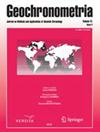The history of the sedimentation processes and heavy metal pollution in the Central Danube Delta (Romania)
IF 0.9
4区 地球科学
Q3 Earth and Planetary Sciences
引用次数: 7
Abstract
Abstract The aim of this study was to investigate the effects of the Iron Gates (IG) hydroelectric power station on the Danube Delta sediment dynamics, and to assess the heavy metal concentrations and pollution in a typical Central Danube Deltaic lake. Eight sediment cores were analysed. The total 210Pb content was measured with 210Po using alpha spectrometry, and the supported 210Pb (226Ra) and 137Cs were measured by gamma spectrometry. The age depth model was derived by applying the 210Pb dating method, and for the calculation of the ages and the sedimentation rates the CRS model was used. The sedimentation rates can be divided into four periods:1940–1972, 1972–1980, 1972–1989 and 1989–2013. In the case of Lake Iacob in the first period, the average sedimentation rate was 0.418 g/cm2y, while in the second it slowly decreased to 0.376 g/cm2y. In the third period, the sedimentation fell to 0.209 g/cm2y, which means the retention of 27.3% of the sediment by the IG dam. In the case of Lake Isac the changes were more visible: in the first period the average sedimentation rate was 0.446 g/cm2y, while in the second it decreased to 0.197 g/cm2y, which means a 42.35% retention of sediment. In the last period, in both cases, a high increase in the sedimentation rate is shown: 0.677 g/cm2y for Lake Iacob and 0.715 g/cm2y for Lake Isac. The heavy-metal concentrations for As, Co, Cr and Ni show decreasing and Hg increasing tendencies, while Cd and Pb show constant values of 310 ± 12 ppb and 9 ± 1 ppm respectively.罗马尼亚多瑙河三角洲中部沉积过程和重金属污染的历史
摘要以多瑙河三角洲中部典型湖泊为研究对象,研究了铁门水电站对多瑙河三角洲沉积物动态的影响,并对多瑙河三角洲中部典型湖泊重金属浓度和污染进行了评价。对8个沉积物岩心进行了分析。用α -能谱法测定210Po的总含量,用γ -能谱法测定负载的210Pb (226Ra)和137Cs。年龄深度模型采用210Pb定年法推导,年龄和沉积速率计算采用CRS模型。沉积速率可划分为1940 ~ 1972年、1972 ~ 1980年、1972 ~ 1989年和1989 ~ 2013年4个时期。以雅各布湖为例,第一时期平均沉积速率为0.418 g/cm2y,第二时期缓慢下降至0.376 g/cm2y。第三期泥沙淤积下降到0.209 g/cm2y,即淤积量为27.3%。以伊萨克湖为例,变化更为明显:第一期平均沉积速率为0.446 g/cm2y,第二期平均沉积速率降至0.197 g/cm2y,泥沙滞留量为42.35%。在最后一个时期,在这两种情况下,沉积速率都显示出高的增加:雅各布湖为0.677 g/cm2y,艾萨克湖为0.715 g/cm2y。重金属As、Co、Cr和Ni的浓度呈下降趋势,Hg呈上升趋势,Cd和Pb的浓度分别为310±12 ppb和9±1 ppm。
本文章由计算机程序翻译,如有差异,请以英文原文为准。
求助全文
约1分钟内获得全文
求助全文
来源期刊

Geochronometria
地学-地球科学综合
CiteScore
2.20
自引率
0.00%
发文量
1
审稿时长
>12 weeks
期刊介绍:
Geochronometria is aimed at integrating scientists developing different methods of absolute chronology and using them in different fields of earth and other natural sciences and archaeology. The methods in use are e.g. radiocarbon, stable isotopes, isotopes of natural decay series, optically stimulated luminescence, thermoluminescence, EPR/ESR, dendrochronology, varve chronology. The journal publishes papers that are devoted to developing the dating methods as well as studies concentrating on their applications in geology, palaeoclimatology, palaeobiology, palaeohydrology, geocgraphy and archaeology etc.
 求助内容:
求助内容: 应助结果提醒方式:
应助结果提醒方式:


